The high romance of Remy Renzullo

Roula Khalaf, Editor of the FT, selects her favourite stories in this weekly newsletter.
Remy Renzullo’s world is one tethered to the splendour of the past. To enter the Islington home of the American decorator is to cross a threshold into a bygone era where every object is rich in patina and provenance. He is inexorably drawn to the faded and fabulous remnants of the 17th and 18th centuries; almost nothing in his rooms – besides a few pieces of contemporary art and a fish plate by ceramicist Katy Stubbs, which was a birthday present – is new.

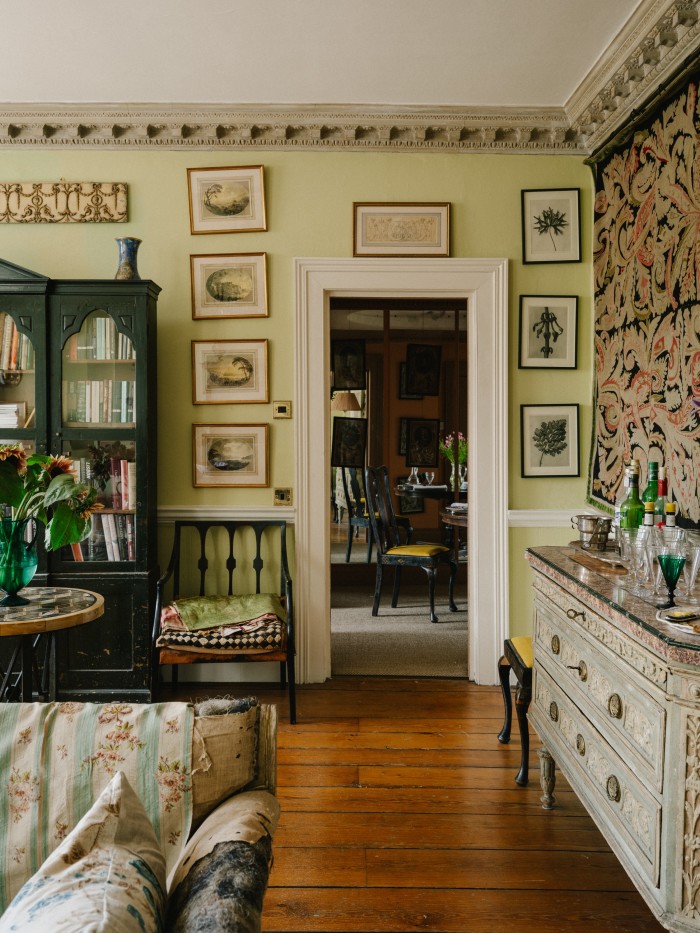
“I’m really a frustrated antiques dealer,” says Renzullo, who is currently in the throes of reviving one of England’s most spectacular houses, Castle Howard in north Yorkshire. At 31, Renzullo is that rare blend of youthful exuberance and expertise. Casually attired in a pale-blue shirt (unbuttoned, European-style, to reveal an expanse of chest), shorts and Venetian slippers, in person he is fleet of mind and word, and yet his research-rich, object-led approach to decorating is defined by an approach that is painstaking and scholarly. Since beginning work at Castle Howard two years ago, he has reworked about a dozen of its estimated 145 resplendent rooms. This is no rush job. The remit set by current incumbents Victoria and Nick Howard is, he says, to do it once and do it well. What started with the private wing, however, has grown into an endeavour he describes as “completely all-consuming”.
“I’ve always said I’d like to spend the rest of my life working on a grand English house,” says the designer, whose role spans the entire property, including undoing the interventions made after a fire at the estate in 1940, when centuries of what he calls “beautiful decay” were hastily erased. In an era of the ready-made, Renzullo delights in being considered. Not that perfection is ever the goal. “I want the rooms to look unstudied, as though they’ve always been there,” he says of his taste for undone spaces, an effect born out of his focus on the curation of objects, rather than masterminding all-encompassing design schemes. “I’m a decorator by trade,” he says. “But I’m weirdly anti-decoration. I hate anything too done-up or perfect – and I always approach rooms furniture-first.”

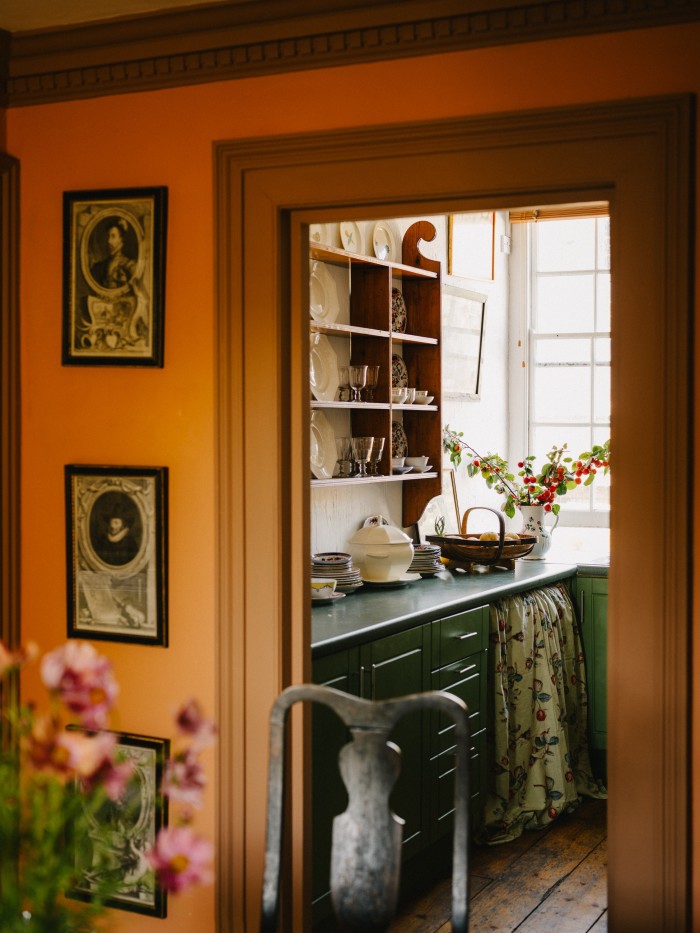
Long attracted to the eccentricity of the English-country-house style, Renzullo views interiors such as Castle Howard as romantic monuments to people’s passions, layered over the generations. This much is true of his own Islington flat, which serves as both a transitory stockroom for his transatlantic projects and a treasure trove of rare and extraordinary antiques. Set across two floors – one inhabited by a studio in the mansard-roofed attic – this 18th-century brown-brick terrace above a café is a Georgian gem hiding in plain sight.
An itinerant soul, Renzullo divides his time between north London (where he can speedily shuttle by train to York), Connecticut (where he shares a home and studio with his father; he renovated a wing of the property, which has been in his family since the late 1800s, during the pandemic) and Italy. It was between lockdowns, while visiting his close friends, the designers Olympia and Ariadne Irving, that he discovered this corner of London. “I started reading up and realised that Islington has some of the finest Georgian architecture in London,” says Renzullo, who drew up lists of his favourite streets and squares. Unlike Chelsea, many of the interiors remained gloriously intact.

Renzullo decided to rent a pied-à-terre in London at around the same time as he won the Castle Howard project; he comes here to work for a few days every month. “I’m afraid of commitment, so I love renting,” he says. In the summer of 2021, he struck gold. “I walked into the drawing room and it had the most beautiful afternoon light of anywhere I’ve ever lived. I thought, this is it,” he explains. He was enticed, too, by the incredibly ornate wooden chimneypiece and cornicing, which recalls the delicately drawn Chippendale-style of master carver Thomas Johnson, stripped back by the property’s owner – a fellow antiques man – to the original wood. “I lucked out,” admits Renzullo, who has kept the existing celery-green-hued walls.
After he stayed in the property to better absorb the atmosphere, the careful process of embellishment began. The drawing room gives way both to the Egyptian-brown bedroom, decked with Sicilian, Greek and Turkish textiles, and a mirrored, sisal-floored entranceway that doubles as a dining room and leads to a small kitchen and a very un-bathroom-like bathroom. The carpeted space features Venetian-Moorish arches and gothic cornicing, and a shower curtain that was once the lining of a cabana on the Lido in Venice in the 1920s.


“At my core I have this spirit of collecting – it’s a family trait,” says Renzullo, who grew up between Maine, New Mexico and what he calls “a remote and WASPish” corner of Connecticut. “My mother is the renegade of a once-grand family. I grew up in the last gasp of a great fortune. This sense of lost splendour is a huge part of my personality.” He is the son of a furniture‑maker, and the family home was filled with curiosities and inherited treasures – from taxidermy to giltwood Georgian furniture, and his mother’s array of Native-American and Inuit art.
“Nothing was precious,” he says of his feral existence, which saw him spend swaths of time with his maternal grandmother, who was a great collector of Chinese export ceramics and 18th-century English furniture. Her interest in the provenance of these pieces left an indelible mark. His boyhood ambition was to become a diplomat – instead, while his sisters went into academia, he studied fashion at Parsons. Having dropped out after two years, he worked alongside Wes Gordon at his eponymous label, an experience that deepened his love of textiles. When he found the detachment between creator and customer unsatisfying, he turned to decorating: his early experiment was his Manhattan apartment, which he filled with “lovely things” borrowed or inherited from his family, or bought at auction and flea markets. “Only at Remy’s could you find a hornet’s nest casually draped over a mirror above the fireplace,” says the artist Angelica Hicks of the idiosyncratic interior of his former apartment in New York, the city where they met and became best friends. Though she’s never asked for his design advice, they have been known to dissect other people’s interiors.

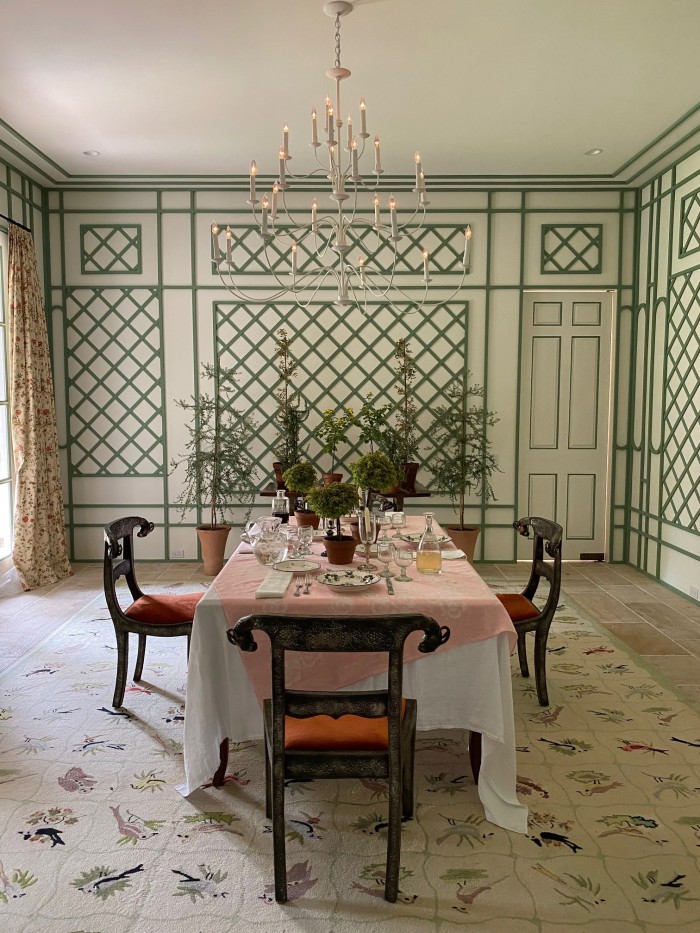
It was lunch with another friend, Lauren Santo Domingo, founder of Moda Operandi, that planted the seed that eventually gave rise to Renzullo’s first project, helping her with her South American home in 2016. “He was charming,” says Santo Domingo of their first meeting. “He spoke with an English accent and had an infectious energy. He has a respect for those who came before him; I still go to him whenever I have a design question. He knows everything. There is no one better to truly take the English-country-house style to the next generation – in matters of taste, he never puts a foot wrong and never offends. And that is very English.” He then worked on a ski house in Jackson, Wyoming, filling it with American folk art furniture and Pierre Frey fabrics. And his transition to interiors was complete. Alongside Castle Howard, Renzullo’s small interior-design and antiques advisory team is currently working on seven projects, including a brownstone in Brooklyn Heights and a Georgian revival home in London’s Chelsea, a two-year project on which he has been given decorative carte blanche.
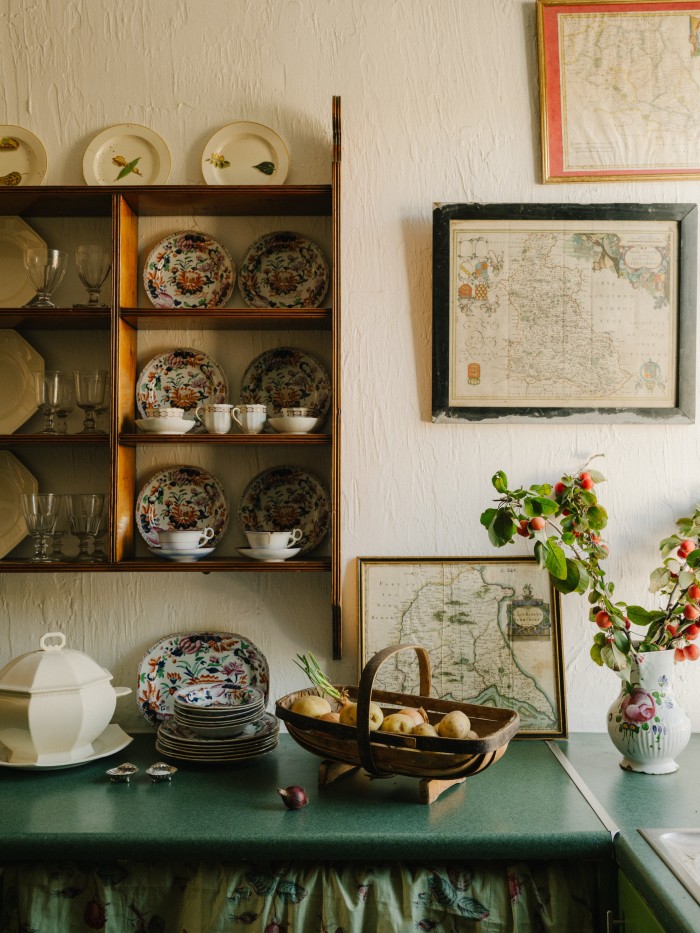
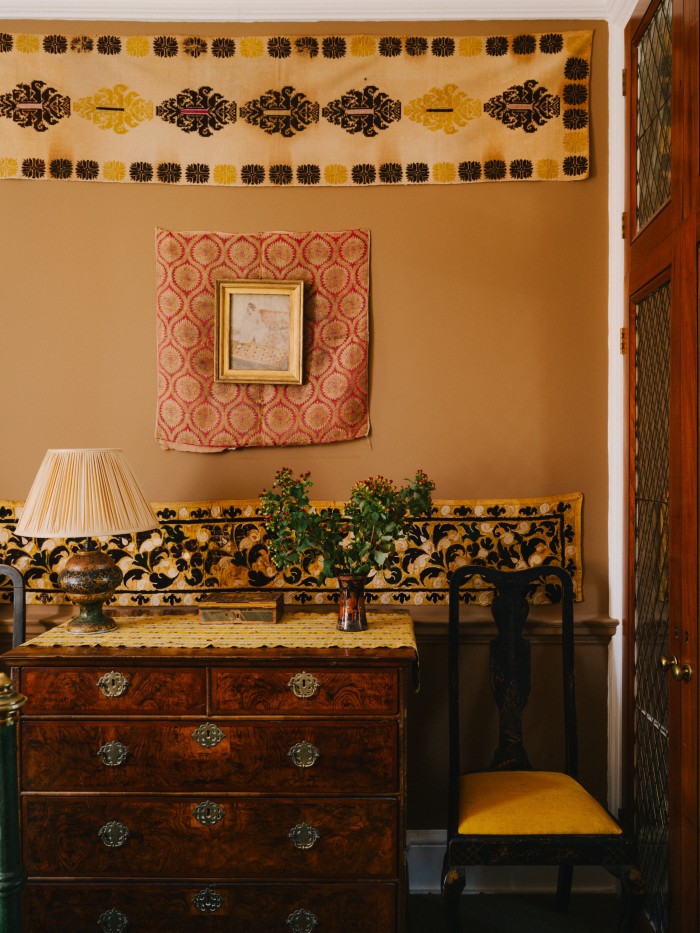
In his own home, many of Renzullo’s acquisitions are happy accidents he has gathered along the way. There’s the yet-to-be-upholstered George III giltwood sofa draped with fragments of Spitalfields silk; the hexagonal Regency faux-bamboo chair (“faux bamboo is my obsession”); and the magical stool fashioned after a forest-floor mushroom that once belonged to Madeleine Castaing (decorator Jacques Grange owns the other). The stool reminds Renzullo of the Scandinavian Elsa Beskow fairy tales he read as a child. Perhaps most prized is his marble-topped, Piedmontese chest of drawers believed to be made by Turin’s esteemed Francesco Bolgiè. “He was one of the greatest cabinet-makers of all time,” he says with unreserved glee.
It’s here in the drawing room that Renzullo starts his London days, sitting at a desk facing his neoclassical commode, which is backed by a wall-hung needlework carpet and surrounded by books, ceramics and glassware, some of which are collected close-by in Camden Passage, where his hero the antiques dealer Christopher Gibbs had his first shop. The walls are filled with architectural finds, including a frieze by James Wyatt designed as an overdoor for Devonshire House, and his collection of works on paper by English artists from the 17th century and beyond.
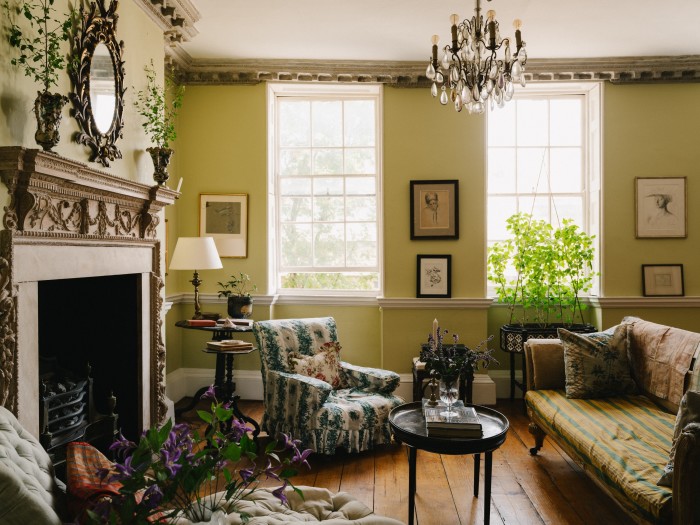
“I’ve always felt a cultural affinity with England,” says Renzullo, whose mornings begin with a pot of coffee, sketching out spaces in pencil on paper and researching and replying to emails from clients, before he migrates upstairs to his studio to engage in more serious design work. Though he readily admits being consumed by social media – he occasionally buys on Instagram – a huge part of his day is spent looking at fabrics and textiles and investigating the provenance of his finds. In his studio, a wall is dedicated to the antique fabric samples he accumulates, with a view to creating his own collection of textiles down the line.

“I believe in keeping my eyes open and trying to see as much as possible,” says Renzullo, whose phone is filled with more than 260,000 pictures. Rather than sit on the beach, he spends his summers seeking out esoteric design destinations – most recently Museo Agostino Pepoli in Trapani, Sicily, home to the southern‑Italian seafaring craft that sees containers and objects decorated with semi-precious stones. “I love cooking,” says Renzullo, standing in his map-filled galley kitchen, “but given the funds, I’d rather spend money on Trapani-ware than on a vast, fancy kitchen.” This is a man whose idea of relaxation is lying in bed poring over auction catalogues.
Meanwhile, his insatiable appetite for historical treasures shows no sign of abating. For Renzullo, nothing is more cutting-edge or timeless than an antique. He gestures to a Neapolitan table from the 1780s inlaid with Pompeii marble in a striking geometric design, which he discovered in a Parisian flea market, and says: “What could be more contemporary than that?”
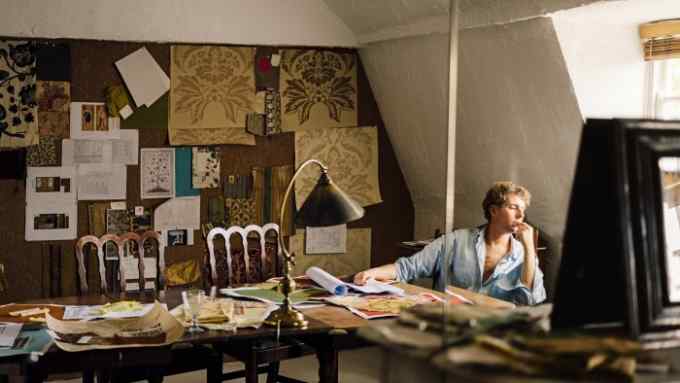
Comments